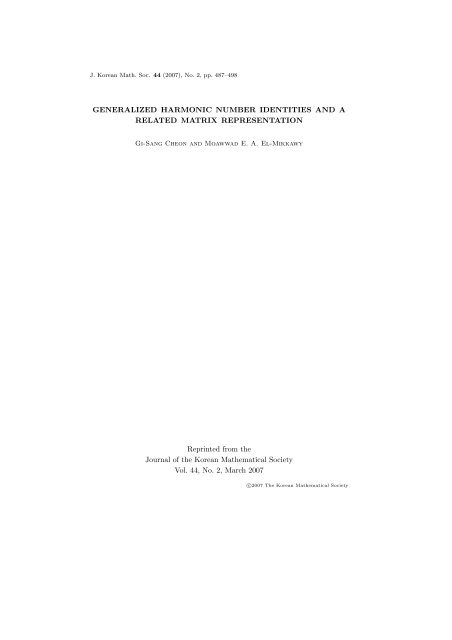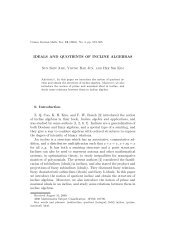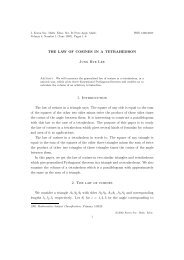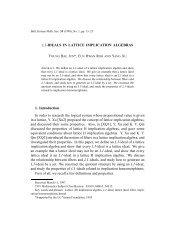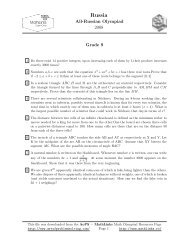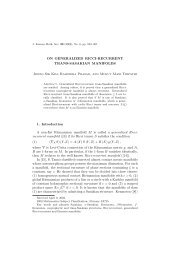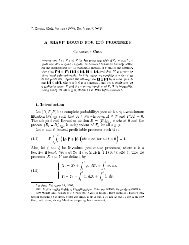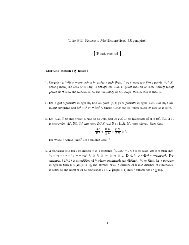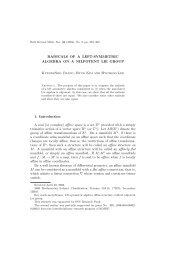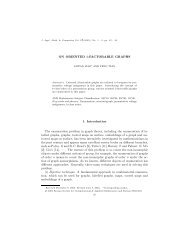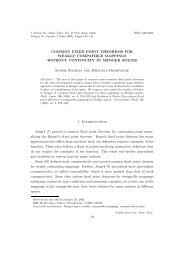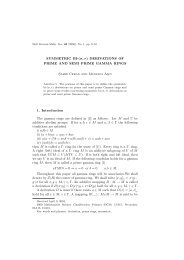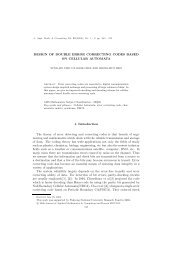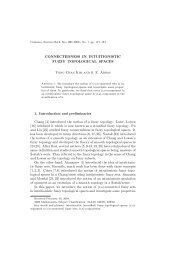GENERALIZED HARMONIC NUMBER IDENTITIES ... - ResearchGate
GENERALIZED HARMONIC NUMBER IDENTITIES ... - ResearchGate
GENERALIZED HARMONIC NUMBER IDENTITIES ... - ResearchGate
Create successful ePaper yourself
Turn your PDF publications into a flip-book with our unique Google optimized e-Paper software.
J. Korean Math. Soc. 44 (2007), No. 2, pp. 487–498<strong>GENERALIZED</strong> <strong>HARMONIC</strong> <strong>NUMBER</strong> <strong>IDENTITIES</strong> AND ARELATED MATRIX REPRESENTATIONGi-Sang Cheon and Moawwad E. A. El-MikkawyReprinted from theJournal of the Korean Mathematical SocietyVol. 44, No. 2, March 2007c○2007 The Korean Mathematical Society
J. Korean Math. Soc. 44 (2007), No. 2, pp. 487–498<strong>GENERALIZED</strong> <strong>HARMONIC</strong> <strong>NUMBER</strong> <strong>IDENTITIES</strong> AND ARELATED MATRIX REPRESENTATIONGi-Sang Cheon and Moawwad E. A. El-MikkawyAbstract. In this paper, we obtain important combinatorial identitiesof generalized harmonic numbers using symmetric polynomials. We alsoobtain the matrix representation for the generalized harmonic numberswhose inverse matrix can be computed recursively.1. Introduction and preliminariesThe ordinary harmonic numbers are denoted by H n and are defined asn∑ 1H 0 = 0 and H n = , n = 1, 2, . . . .kThe first few harmonic numbers are 1, 3 2 , 11 6 , 2512 , 13760, . . .. These harmonic numberswere studied in antiquity and are important in various branches of numbertheory and combinatorial problems. They are closely related to the Riemannzeta function defined by∞∑ 1ζ(s) =n s = ∏ (1 − p −s ) −1 ,pn=1where the product is over all primes p, and appear in various expressions forvarious special functions. It is well known that|s(n + 1, 2)|(1) H n = ,n!where s(n, k) denotes the Stirling numbers of the first kind defined byn∏n∑(x) n := (x − r + 1) = s(n, k)x k .r=1For a notational convenience, we denote c(n, k) = |s(n, k)|, i.e., c(n, k) is theunsigned Stirling number of the first kind which counts the permutations of nReceived June 1, 2006.2000 Mathematics Subject Classification. 05A30.Key words and phrases. harmonic numbers, Riemann zeta function, Stirling numbers,Bernoulli numbers, symmetric polynomials.k=1k=0487c○2007 The Korean Mathematical Society
488 GI-SANG CHEON AND MOAWWAD E. A. EL-MIKKAWYelements that are the product of k disjoint cycles. Further, It is known [9] thatζ(k + 1) =∞∑n=kc(n, k)n · n! .In many recent works (see for example [1]-[5],[7]-[10]), the harmonic numbershave been generalized by several ways and the related identities were obtained.Our observations suggest that the generalized harmonic numbers can be viewedcombinatorially.For instance, the generalized harmonic numbers H n(r) of order r are definedto be partial sums of the Riemann zeta function:(2) H (r)0 = 0 and H (r)n =n∑k=1It is known (p.217 in [6]) that the numbers H (r)nc(n + 1, 1) = n!,c(n + 1, 2) = n!H n ,c(n + 1, 3) = n!2 (H2 n − H (2)n ),1, n, r ≥ 1.kr c(n + 1, 4) = n!6 (H3 n − 3H n H (2)n + 2H (3)n ),and c(n, r) are connected byand so on. In [1], Adamchik obtained the general formula for c(n, m) in termsof generalized harmonic numbers H (r)n :(3) c(n, m) =(n − 1)!w(n, m − 1),(m − 1)!where the w-sequence is defined recursively bym−1∑(4) w(n, 0) = 1, w(n, m) = (−1) k (m − 1) k H (k+1)n−1 w(n, m − 1 − k).k=0And he showed the w-sequence can be rewritten through a multiple sum:w(n, m) =n−1∑n−1∑i 1=1 i 2=i 1+1· · ·n−1∑i m=i m−1+1m!i 1 i 2 · · · i m.In [5], Chu and Donno defined the generalized harmonic numbers H n (r) by(5) H 0 (r) = 0 and H n (r) =n∑k=11k + r , n ≥ 1,and they obtained several striking identities on the ordinary harmonic numbers.
<strong>GENERALIZED</strong> <strong>HARMONIC</strong> 489For the rising factorial [x] n = x(x + 1) · · · (x + n − 1) (n ≥ 1), by writingas the sum of p + 1 partial fractions we obtain:1[r] p+1(6)1[r] p+1=p∑k=0A (p)kk + r = 1 p!p∑k=0( pk) (−1)kk + r ,where A (p)k= 1/ ∏ pt=0(t − k), t ≠ k. It is easy to show that (6) can also beobtained by using the fact that∆ n ( 1 x ) = (E − 1)n ( 1 x ) = (−1)n n![x] n+1,where ∆ and E are the forward and the shift operators with unit step, respectively.The rising factorial [r] p+1 satisfies the following identity, typicallyproved by induction or telescoping sums [11]:(7)n∑r=11[r] p+1=( n+pp)− 1), p ≥ 1.p(p!) ( n+ppUsing (6) and (7), we can establish an interesting identity for the generalizedharmonic numbers H n (r):p∑( ) ( n+p)p(−1) r p − 1H n (r) =rp ( )n+p.pr=0Besides, in [2], Benjamin et. al. showed that the generalized harmonicnumbers H n defined by(8) H n = 1 n∑and H n = H k,nn, r ≥ 1can be expressed in terms of r-Stirling numbers. In 1997, Santmyer [10] definedthe generalized harmonic numbers H n,r of rank r by∑ 1(9) H n,r =, n ≥ 1, r ≥ 0.k 0 k 1 · · · k rk 0 +···+k r ≤nNote that these generalized harmonic numbers H n(r) , H n (r), H nreduce to the ordinary harmonic numbers H n when r = 1 or r = 0.r=1In this paper, we define other generalized harmonic numbersH(n, r) :=c(n + 1, r + 1)n!and H n,rwhich are direct generalization of (1). The purpose of this paper is to obtainsome interesting identities involving H(n, r). These results are derived fromsymmetric polynomials. Further, we give a matrix representation for H(n, r).
490 GI-SANG CHEON AND MOAWWAD E. A. EL-MIKKAWY2. Symmetric polynomialsIn this section, we are going to consider the so-called symmetric polynomialswhich are not only important tool in mathematics but also play considerableroles in computer science, physics and statistics.A polynomial P (x 1 , x 2 , . . . , x n ) in the variables x 1 , x 2 , . . . , x n is called asymmetric polynomial or symmetric function if it is invariant under all possiblepermutations of the variables x 1 , x 2 , . . . , x n . Especially, important symmetricpolynomials that will be considered in the current paper are the elementarysymmetric polynomial σ (n)(n)k, the complete symmetric polynomial τk, and thepower sum symmetric polynomial S (n)kon the variables x 1 , x 2 , . . . , x n . Thesepolynomials for integers n, k with n ≥ k ≥ 0 are defined by:(10)(11)(12)• σ (n)k (x 1, x 2 , . . . , x n ) =• τ (n)k (x 1, x 2 , . . . , x n ) =• S (n)k (x 1, x 2 , . . . , x n ) =∑1≤r 1
<strong>GENERALIZED</strong> <strong>HARMONIC</strong> 491These functions satisfy E(t)F (−t) = F (t)E(−t) = 1 andr∑(18)(−1) m σ (r)m τ (r)r−m = δ r0m=0for specific non-negative integers n and r such that 0 ≤ r ≤ n, where δ nkis the Kronecker symbol. The unsigned Stirling numbers of the first kindc(n, k) and the Stirling numbers of the second kind S(n, k) defined by x n =∑ nk=0 S(n, k)(x) k are related to σ (n)kand τ (n)kby(19) c(n, k) = σ (n−1)n−k(1, 2, . . . , n − 1),(20) S(n, k) = τ (k)n−k(1, 2, . . . , k).Before we consider more generalized harmonic number identities it may beuseful to give the following result.Lemma 2. For all nonzero real numbers x 1 , x 2 , . . . , x n and for all nonnegativeinteger i, we have(21) σ (n)i ( 1 x 1, 1 x 2, . . . ,r=01x n) =1x 1 x 2 · · · x nσ (n)n−i (x 1, x 2 , . . . , x n ).Proof. Replacing each x i by 1 x iin (16) gives:n∑σ r (n) ( 1 , 1 1, . . . , )t r 1=x 1 x 2 x n x 1 x 2 · · · x nHencen∑i=0σ (n)i ( 1 x 1, 1 x 2, . . . ,The result follows.1x n)t i =1x 1 x 2 · · · x nn ∑i=0n ∏i=1(t + x i ).σ (n)n−i (x 1, x 2 , . . . , x n )t i .As a direct consequence of Lemma 2, we see that for specific positive integern, the special case x i = i for each i = 1, 2, . . . , n yields:(22) σ (n)i (1, 1 2 , . . . , 1 n ) = 1 n! σ(n) n−i (1, 2, . . . , n).□Lemma 3. For integers n, m with n ≥ m ≥ 2, we have(23) c(n, m) = (n − 1)! σ (n−1)m−1 (1, 1 2 , . . . , 1n − 1 ).Proof. With the help of (22) and (19) we obtainc(n, m)(n − 1)! = 1(n − 1)! σ(n−1) n−m (1, 2, . . . , n − 1) = σ (n−1)m−1 (1, 1 2 , . . . , 1n − 1 ),which proves (23).□
492 GI-SANG CHEON AND MOAWWAD E. A. EL-MIKKAWYFrom Lemma 3 and (3), we immediately obtain a simple representation forthe w-sequence:(24) w(n, m) = m!σ (n−1)m (1, 1 2 , . . . , 1n − 1 ).Further, using the recurrence relation (25) enables us to compute the numbersw(n, w) recursively as follows:w(i, j) = w(i − 1, j) +j w(i − 1, j − 1), i ≥ 2, j ≥ 1i − 1so that w(i, i) = 0 and w(i, 0) = 1 for i ≥ 0, and w(i, 1) = H i−1 for i ≥ 1.3. Generalized harmonic numbers H(n, r)We begin with the recurrence relation for the unsigned Stirling numbers ofthe first kind c(n, r) in [6]:(25) c(n, r) = c(n − 1, r − 1) + (n − 1)c(n − 1, r), n, r ≥ 1with c(n, 0) = δ n0 , c(n, n) = 1, c(n, 1) = (n − 1)! for n ≥ 1. The relation (25)also gives c(n + 1, 2) = c(n, 1) + nc(n, 2). Dividing both sides by n! taking intoaccount the fact that c(n, 1) = (n − 1)!, we obtain(26) g(n) = 1 + g(n − 1), n ≥ 1,nwhere g(n) = c(n + 1, 2)/n!. Since H n = 1 n + H n−1, n ≥ 1, from (26) we obtaing(n) = H n which proves (1).More generally, we may rewrite the recurrence relation (25) in the form:(27)c(n + 1, r + 1)n!= 1 c(n, r)n (n − 1)!c(n, r + 1)+ .(n − 1)!Let us define the generalized harmonic numbers H(n, r) by(28) H(n, 0) = 1 and H(n, r) =c(n + 1, r + 1)n!n, r ≥ 1.First note that from (27) the numbers H(n, r) satisfy the recurrence relation:(29) H(n, r) = H(n − 1, r) + 1 H(n − 1, r − 1).nTheorem 4. The generalized harmonic numbers H(n, r) satisfy∑ 1(30) H(n, r) =.k 1 k 2 · · · k rProof. From Lemma 3, we have1≤k 1
<strong>GENERALIZED</strong> <strong>HARMONIC</strong> 493Hence using (10) yieldsThis completes the proof.H(n, r) =∑1≤k 1
494 GI-SANG CHEON AND MOAWWAD E. A. EL-MIKKAWY(iii) ∑ nj=r 1 jH(j − 1, r − 1) = H(n, r),(iv) ∑ nr=0 (−1)r H(n, r)(B r+1 (n + 1) − B r+1 ) 1r+1 = 1,(v) ∑ nr=0 H(n, r)(B r+1(n + 1) − B r+1 ) 1r+1 = ( )2n+1n ,(vi) ∑ nr=1 rH(n, r) = (n + 1)(H n+1 − 1),(vii) ∑ nr=0 (2r − 1)H(n, r) = ( )n+12 .Proof. Putting t = 1 in (33) and taking into account the fact that H(n, 0) = 1gives (i). Similarly putting t = −1 in (33) yields the identity (ii). To prove(iii), sinceapplying (14) givesH(n, r) = σ (n)r (1, 1 2 , . . . , 1 n ) = ∑H(n, r) == 1 rn∑k∑r −1k r =r k r−1 =r−1∑r−1k∑2 −1· · ·k r−1−1∑k 1 =1k r−1=r−1 k r−2=r−2+ 1r + 1+ 1 nr∑1≤k 1
<strong>GENERALIZED</strong> <strong>HARMONIC</strong> 495Consequently, by using (34) and (13) we obtainn∑(35)(−1) r+1 1H(n, r)(B r+1 (n + 1) − B r+1 )r + 1 = n.r=1The identity (35) can also be written in the form:n∑(−1) r 1H(n, r)(B r+1 (n + 1) − B r+1 )r + 1 = 1.r=0To prove (v), from (33) we haven∑( ) n + tH(n, r)t r =nHence(36)n∑t=0 r=0r=0n∑H(n, r)t r =n∑n∑H(n, r)( t r ) =r=0t=0= (n + t) n.n!n∑( ) ( )n + t 2n + 1= .n nUsing (34) then (36) yieldsn∑( )1 2n + 1H(n, r)(B r+1 (n + 1) − B r+1 )r + 1 = ,nr=0which is the required result. To prove (vi), using (33) we obtainn∑(37)H(n, r)t r = (t + n) n= 1 n∏(t + r).n! n!r=0Differentiating both sides of (37) with respect to t givesn∑( ) n + t ∑ n ( )(38) rH(n, r)t r−1 1 n + t=n t + r = (H n+t − H t ).nr=1r=1t=0r=1Putting t = 1 in (38) yieldsn∑rH(n, r) = (n + 1)(H n+1 − 1),r=1as required. To prove (vii), by using the forward operator ∆ with unit step,then (37) yieldsn∑∆( H(n, r)t r ) = ∆( (t + n) n).n!Hencer=0n∑H(n, r)∆(t r ) = 1 n! ∆((t + n) n).r=0
496 GI-SANG CHEON AND MOAWWAD E. A. EL-MIKKAWYConsequently, we haven∑(39) H(n, r)((t + 1) r − t r ) = n n! (t + n) n−1 = (t + n) n−1(n − 1)!r=0Setting t = 1 in (39), we obtainn∑(2 r − 1)H(n, r) =r=0This completes the proof of the theorem.( ) n + 1=n − 1( n + 12).=( ) n + t.n − 1□We list more new identities for the generalized harmonic numbers H(n, r)without proofs.(i) H(n, r) = 1 ∑ n( k)n k=r r H(n − 1, k − 1),(ii) ∑ nr=k H(n, r)S(r + 1, k + 1) = ( )n n+1k (k+1)! ,(iii) ∑ nk=0 (−1)k+1 H(n, k)B k+1 = n+1n+2 ,(iv) ∑ n−r+1k=1= rH(n, r).H(n−k,r−1)k4. Matrix representationFor the generalized harmonic numbers H(n, k) defined by (28) we define then × n matrix H = [h ij ] 1≤i,j≤n as follows:{H(i, j) if i ≥ j,h ij =0 if i < j.For example, the 5 × 5 matrix H is given by⎡1 0 0 0 03 12 20 0 0H =1116160 025 35 5 1⎢ 12 24 12 240⎣137601581724Here the elements of the matrix H are computed recursively using (29). Using(18) we see that the inverse matrix Q = [q ij ] 1≤i,j≤ of H is given by{(−1)q ij =i+j j!τ (j+1)i−j (1, 2, . . . , j + 1) if i ≥ j,0 if i < j.Using (21) yieldsq ij =181120⎤.⎥⎦{(−1) i+j j!S(i + 1, j + 1) if i ≥ j,0 if i < j.
<strong>GENERALIZED</strong> <strong>HARMONIC</strong> 497For example, we obtain the 5 × 5 matrix Q as follows:⎡⎤1 0 0 0 0−3 2 0 0 0Q =⎢ 7 −12 6 0 0⎥⎣ −15 50 −60 24 0 ⎦ .31 −180 390 −360 120It is worthy to mention that the elements of the inverse matrix Q can also becomputed recursively using the recurrence relationwithq ij = jq i−1,j−1 − (j + 1)q i−1,j , i = 3, 4, . . . , n; j = 2, 3, . . . , i − 1,q i1 = (−1) i+1 (2 i − 1) for i ≥ 1; q ii = i! for i ≥ 1.Due to the identity (i) of Theorem 5, the product DH is a stochastic matrix,where D = diag(1, 1 2 , . . . , 1 n ).We conclude this paper by describing that the matrix representation for thegeneralized harmonic numbers may be used to get more identities and somecombinatorial connections with other combinatorial numbers.Acknowledgment. The authors would like to thank the referee for valuablecomments and suggestions.References[1] V. Adamchik, On Stirling numbers and Euler sums, J. Comput. and Appl. Math. 79(1997), no. 1, 119–130.[2] A. T. Benjamin, D. Gaebler, and R. Gaebler, A combinatorial approach to hyperharmonicnumbers, Integers (Elec. J. Combi. Number Theory) 3 (2003), A15, 1–9.[3] S. Chaturvedi and V. Gupta, Identities involving elementary symmetric functions, J.Phys. A 33 (2000), no. 29, L251–L255.[4] W. Chu, Harmonic number identities and Hermite-Padé approximations to the logarithmfunction, J. Approx. Theory 137 (2005), no. 1, 42–56.[5] W. Chu and L. De Donno, Hypergeometric series and harmonic number identities, Adv.in Appl. Math. 34 (2005), no. 1, 123–137.[6] L. Comtet, Advanced Combinatorics, D. Reidel Pub. Company, 1974.[7] A. Gertsch, Generalized harmonic numbers, C. R. Acad. Sci. Paris, Sér. I Math. 324(1997), no. 1, 7–10.[8] I. M. Gessel, On Miki’s identity for Bernoulli numbers, J. Number Theory 110 (2005),no. 1, 75–82.[9] T. M. Rassias and H. M. Srivastava, Some classes of infinite series associated withthe Riemann Zeta and Polygamma functions and generalized harmonic numbers, Appl.Math. Comput. 131 (2002), no. 2-3, 593–605.[10] J. M. Santmyer, A Stirling like sequence of rational numbers, Discrete Math. 171 (1997),no. 1-3, 229–235.[11] F. Scheid, Numerical Analysis, McGraw-Hill Book Company, 1968.[12] A. J. Sommese, J. Verscheide, and C. W. Wampler, Symmetric functions applied todecomposing solution sets of polynomial systems, SIAM J. Numerical Analysis 40 (2002),no. 6, 2026–2046.[13] http://mathworld.wolfram.com/Newton-GirardFormulas.html.
498 GI-SANG CHEON AND MOAWWAD E. A. EL-MIKKAWYGi-Sang CheonDepartment of MathematicsSungkyunkwan UniversitySuwon 440-746, KoreaE-mail address: gscheon@skku.eduMoawwad E. A. El-MikkawyDepartment of MathematicsFaculty of Science of Mansoura UniversityMansoura 35516, EgyptE-mail address: mikkawy@yahoo.com


